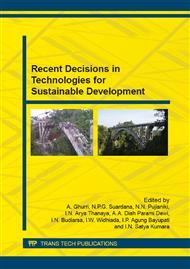p.413
p.419
p.425
p.431
p.437
p.443
p.449
p.455
p.461
Improving Biogas Quality through Circulated Water Scrubbing Method
Abstract:
The dependence of human being on fossil fuels has decreased significantly the conventional energy resources. To overcome this problem it is required alternative substitute fuels which are cheap and accessible which biogas is one of the fuels. Nevertheless, the use of biogas has not yet been maximized because of the low calorific value which is produced from the process without purification. The circulated water absorption method is one mean of effective biogas purification. Under this method it is expected to increase the level of methane (CH4) and to reduce both the level of carbon dioxide (CO2) and hydrogen sulfide (H2S). In order to obtain the aim, the research was carried out under variations of water and biogas volumetric flow rate. The results show that the highest quality of biogas produced was under the variation of water volumetric flow rate of 15 lt/min with biogas volumetric flow rate of 1 lt/min which increased the level of methane (CH4) from 59.36 % to 62.8 % and decreased the carbon dioxide (CO2) content from 33.53 % to 26.8 %, and hydrogen sulfide (H2S) from 208.33 to 86 ppm. Lower biogas and water volumetric rates allowed longer contact between biogas molecule and absorbent. This resulted in an opportunity for absorbent more active to dissolve carbon dioxide and hydrogen sulfide in biogas. These compounds then flowed outward of the scrubbing unit along with the absorbent. The research proved that the raw biogas purification by circulated water scrubbing method was an effective mean in enhancing the quality of biogas.
Info:
Periodical:
Pages:
443-448
Citation:
Online since:
July 2015
Keywords:
Price:
Сopyright:
© 2015 Trans Tech Publications Ltd. All Rights Reserved
Share:
Citation:


